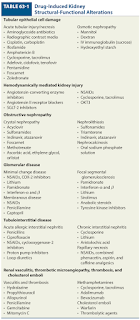Drug-Induced Kidney Disease (DIKD)
Introduction
Drug-induced kidney disease (DIKD) can be either
- Acute and reversible when the medication is stopped, or
- Irreversible and progress to chronic kidney disease.
- Adjustment of medication dosage regimens based on accurate estimates of kidney function
- Careful and adequate hydration to establish high urine flow rates.
Nephrotoxic Medications
Common examples include
- Aminoglycosides
- Amphotericin B
- Angiotensin-Converting Enzyme Inhibitors and Angiotensin II Receptor Blockers
- Cisplatin
- Cyclosporine
- Loop Diuretics
- Nonsteroidal Anti-inflammatory Drugs and Selective Cyclooxygenase-2 Inhibitors
- Polymyxins
- Proton Pump Inhibitors
- Radiographic Contrast Media
- Tacrolimus
- Vancomycin
NOTE: May refer Pharmacotherapy A Pathophysiologic Approach for detailed explanations.

Comments
Post a Comment